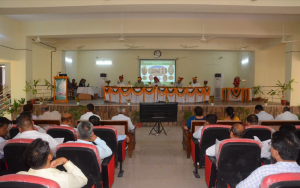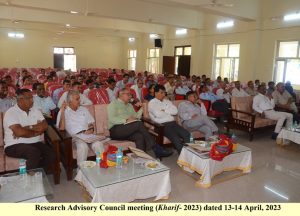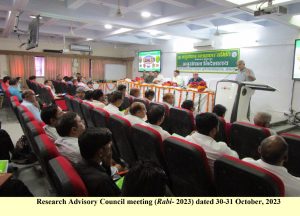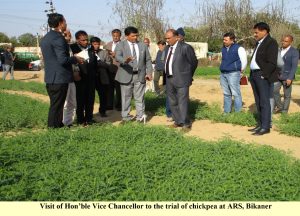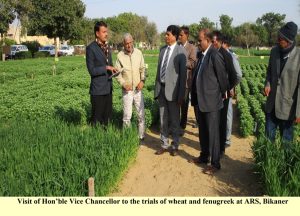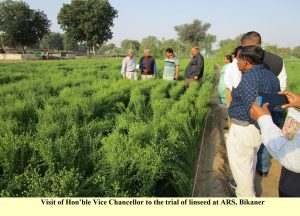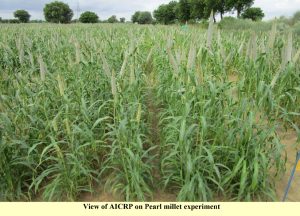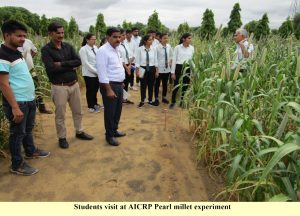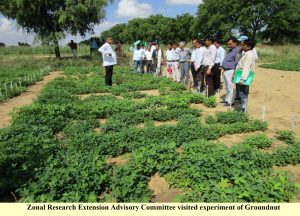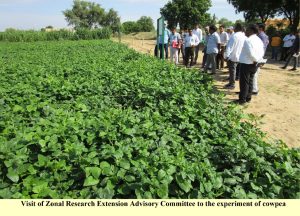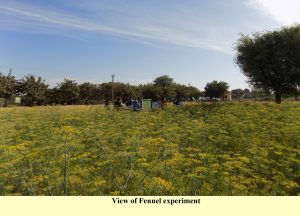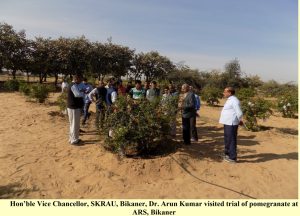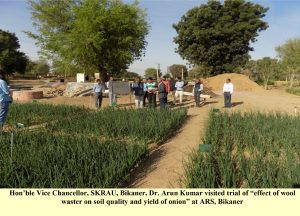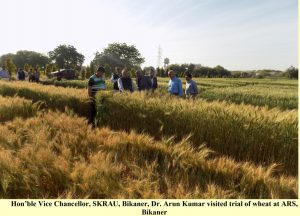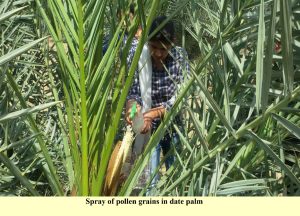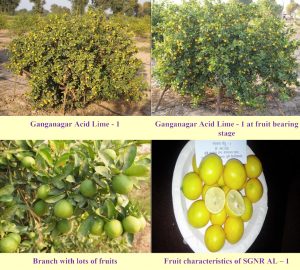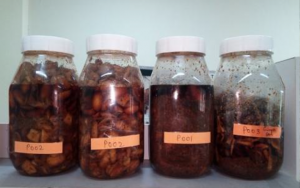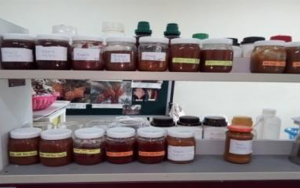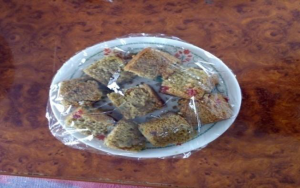Swami Keshwanand Rajasthan Agricultural University, Bikaner
स्वामी केशवानन्द राजस्थान कृषि विश्वविद्यालय, बीकानेर
Quick Links
Quick Links
Directorate of Research

Introduction:
To provide a systematic and coordinated approach to agricultural research, Directorate of Research unit was established at the university headquarter at Bikaner in 1992. At present the directorate caters the need of the farmers of six districts viz., Bikaner, Jaisalmer, Churu, Jhunjhunu, Hanumangarh and Sriganganagar covering three agro-climatic zones namely Irrigated north western plain (Ib), Hyper arid partially irrigated western plain (Ic) and parts of transitional plain of inland drainage (IIa).
Presently, 15 All India Coordinated Research Projects, 22 short/ long term projects and many non-plan projects are being run to develop production and protection technologies. The Directorate is also engaged in seed production programme. National Seed Project unit of Directorate ensures quality seeds production of high yielding varieties and fulfill the farmers demand of jurisdiction are to enhance the crop production.
Mandate:
- To plan, coordinate and monitor need-based agricultural research
- To develop new and improved crop varieties as well as appropriate production technologies for
- optimal use of natural resources in a sustainable manner
- To coordinate and monitor the breeder seed production
- To develop linkages with national and international organizations for fundamental and applied research
- To strengthen the research capabilities of Zonal Research Stations, and
- To extend consultancy and expertiseness

SKRAU Research System and seed production
| ARS-Bikaner | ARS-SriGanganagar | ARSS- Hanumangarh | National Seed Project Bikaner |
|---|---|---|---|
| Establishment year-1995 Area- 146 ha | Establishment in 1977 Area- 78.6 ha | Establishment year -1976 Area- 56 ha | Establishment in 1987 Seed Farms: • MAF-Rozari (508 ha) • UCF-Khara (250 ha) • USF- Bikaner (75 ha) |
Administrative Staff of Directorate of Research
| Name | Designation | Specialization | Contact details | |
|---|---|---|---|---|
| Dr. P. S. Shekahawat | Director | Agronomy | 0151-2250199 9414604614 | dor@raubikaner.org pssbkn@yahoo.co.in |
| Dr. Yogesh Sharma | Additional Director | Soil Science & Agri. Chemistry | 9414544738 | yogeshcoabikaner@gmail.com |
| Dr. J. K. Gaur | Deputy Director | Ag. Engineering | 8949747344 | jkgbkn@gmail.com |
| Sh. Vikash Sharma | Asstt. Professor | Microbiology | 9672658910 | vikash.sharma2407@gmail.com |
| Sh. Vishnu P. Agarwal | Asstt. Professor | Plant Physiology | 9460192043 | vpa1978@gmail.com |
Addl. Director/Zonal Directors/ Officer Incharge
| Name | Research Station | Specialization | Contact No. | E-mail address |
|---|---|---|---|---|
| Dr. P.C. Gupta | ADR (seed) | Genetics & Plant Breeding | 0151-2251513 | nspbikaner@gmail.com |
| Dr. Vijay Prakash | Sriganganagar | Genetics & Plant Breeding | 0154-2440619 | arssgnr2003@gmail.com |
| Dr. S. R. Yadav | Bikaner | Soil Science & Agri. Chemistry | 0151-2250570 | adrb@raubikaner.org |
| Dr. Hanuman Ram | Hanumangarh | Agri. Extn. Edu. | 01552-222935 9783004900 | arsshng@gmail.com |
| Dr. B.S. Meena | M.A.F. Rojari | Agri. Extn. Edu. | 8764375302 | bsmeena1969@rediffmail.com |
| Dr. B. D. S Nathawat | UCF, Khara | Plant pathology | 8769791063 | dsnathawat@gmail.com |
All India Co-ordinate Research Projects
| Name of projects | Source of finance (75%+25%) | Date of starting | Project Incharge |
|---|---|---|---|
| ARS, Sriganganager | |||
| AICRP on Chickpea | ICAR +State | 1988 | Dr. Vijay Prakash |
| AICRP on Cotton | ICAR +State | 1967 | Dr. Pradeep Kumar |
| AICRP on Sugarcane | ICAR +State | 1999-2000 | Dr. Raghuveer Meena |
| AICRP Water Management Project | ICAR +State | 1980 | Dr. Raghuveer Meena |
| AICRP on Rape Seed & Mustard | ICAR +State | 1993-94 | Dr. L.K. Jain |
| AICRP on Tropical Fruits | ICAR +State | 2009-10 | Dr. Ravi Meena |
| AICRP on STCR | ICAR +State | 1996 | Dr. L.K. Jain |
| ARS Bikaner | |||
| AICRP-AZF(Date Palm) | ICAR + State | 1979 | Dr. R.S. Rathore |
| AICRP on STCR | ICAR + State | 1996 | Dr. S. R. Yadav |
| AICRP on Salinity | ICAR + State | 1991-92 | Dr. Bhupendra Singh |
| AICRP on Groundnut | ICAR + State | 1993 | Dr. Sujeet Kumar Yadav |
| AICRP on Pearl millet | ICAR + State | 1995 | Dr. P. S. Shekhawat |
| AICRP on Forage crops | ICAR + State | 1995 | Dr. A.S. Godara |
| AINP on Arid legumes(Mothbean) | ICAR + State | 1986 | Dr. H.L. Deshwal |
| NSP, Bikaner | |||
| AICRP on Breeder Seed Production | ICAR + State | 2006 | Dr. P.C. Gupta |
| AICRP on NSP | ICAR + State | 1987 | Dr. P.C. Gupta |
| Others | |||
| Integrated Agro-met Advisory Services | GOI | 1996 ARS, SGNR | Dr. Raghuveer Meena |
| Precision Farming Development Centre | NCPAH | 1995 ARS, Bikaner | Er. J. K. Gaur |
| Integrated Agro-met Advisory Services | GOI | 1995 ARS, Bikaner | Dr. R. K. Yadav |
| Long term other projects | |||
| Gramin Krishi Mausam Sewa | MoES, GOI | 1996 | ARS, Sriganganagar |
| Precision Farming Development Centre | NCPAH, GOI | 1995 | ARS, Bikaner |
| Gramin Krishi Mausam Sewa | MoES, GOI | 1996 | ARS, Bikaner |
| Forecasting Agricultural output using Space, Agro meteorology and Land based observations (FASAL) Scheme | MoES, GOI | 2011 | ARS, Bikaner |
Rashtriya Krishi Vikash Yojana (RKVY) projects Running in the University (On-going)
| Title of project | Duration of project | Total Budget (in lakh) | Operating Centers |
|---|---|---|---|
| Establishment of Mushroom, spawn production and training unit for development of agro entrepreneurs in hyper arid region of Rajasthan | 2021-22 to 2024-25 | 63.452 | COA, Bikaner |
| Effect of Sajji cultivation and foliar fertilization on reclamation of saline soil with quality and productivity of Khar in western Rajasthan. | 2023-24 to 2027-28 | 108.94 | COA, Bikaner |
| Genetic enhancement of pearl millet for productivity improvement and nutrition security in hot-arid regions of Rajasthan | 2023-24 to 2027-28 | 96.91 | ARS, Bikaner |
| Enhancing soil quality and productivity through agro-industries organic waste in arid region of Rajasthan. | 2023-24 to 2025-26 | 90.11 | ARS, Bikaner |
| Survey and management of red palm mite (Raoiella indica) in western Rajasthan. | 2023-24 to 2025-26 | 56.10 | COA, Bikaner |
| Revival, purification and quality seed production of elite land races of important crops of arid zone | 2023-24 to 2025-26 | 49.00 | NSP, Bikaner |
| Survey of foliage feeders in groundnut and their management in Bikaner district | 2023-24 to 2025-26 | 34.00 | KVK, Bikaner |
Other funded Projects Running in the University (On-going)
| Title of the project | Name of funding agency | Duration of project | Operating Centers | Total Budget (in lakh) |
|---|---|---|---|---|
| Development and Popularization of Watershed based eco-friendly IFS model for sustainable Production and Income in MANDAWA-Jhunjhunu Region | Directorate of Watershed Development and Soil Conservation, Jaipur | 2023-24 to 2025-26 | LSRCCOA, Mandawa | 122.35 |
| Landscaping of degraded pastures/waste lands of Bikaner district through silvi-pastoral interventions for ensuring higher fodder availability | Directorate of Watershed Development and Soil Conservation, Jaipur | 2023-24 to 2025-26 | ARS, Bikaner | 101.50 |
| Propagation and plantation of important plants of hyper arid region of Rajasthan | Directorate of Watershed Development and Soil Conservation, Jaipur | 2023-24 to 2025-26 | Directorate LS & RG, Bikaner | 93.27 |
| Bamboo for Arid Ecosystem: An Initial Attempt | Dept. of Ag. & Farmers Welfare, GOI, New Delhi | 2023-24 to 2025-26 | COA, Bikaner | 47.00 |
| Find out the Possibilities of Profitable Olive Cultivation in North-Western Rajasthan | ROCL, Jaipur | 2022-23 to 2024-25 | DOR, Bikaner | 38.74 |
Major Research achievements of last three years
New Varieties developed during last three years by SKRAU, Bikaner
| S. No. | Crop | Variety | Notification Number | Released through | Ecology |
|---|---|---|---|---|---|
| 1 | Chickpea | GNG 2461 (Moomal) | 4222(E) dated 25.09.2023 | CVRC | Rainfed conditions of NWPZ |
| 2 | Chickpea | GNG 2261 (Keshav) | 8(E) dated 24.12.2021 | SVRC | Late sown conditions of Rajasthan |
| 3 | Cotton | RS 2827 | 8(E) dated 24.12.2021 | CVRC | High Density Planting of North Zone |
| 4 | Cotton | RS 2818 | 8(E) dated 24.12.2021 | CVRC | High Density Planting of North Zone |
| 5 | Acid lime | Ganganagar Acid Lime-1 | 1480 (E) dated 01.04.2021 | SVRC | Rajasthan state |
Chickpea
GNG 2461 (Moomal):
This variety was developed through pedigree selection method of dual hybridization between a single hybridization of KWR-108 &G.N.G. -1861 and another single hybridization of Pant G.-186 and G.N.G. 1958. New variety G.N.G. 2461 (Moomal) has given an average yield of 2140 kg per hectare in rainfed conditions, which is better than other variety RSG. – 888 to 26.5 percent, R.S.G.- 931 to 19.2 percent, C.S.J. – 515 to 7.7 percent and I.P.C.L.- 4-14 to 11.2 percent more. This variety has relatively high resistance to wilt and dry root rot. The grains of this variety are thick and brown in color and the average weight of 100 grains is about 24.5 grams.
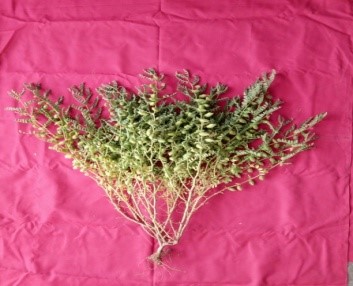
GNG 2261 (Keshav):
The desi chickpea variety GNG 2261 (Keshav) developed by AICRP on Chickpea, ARS, Sriganganagar was released and notified for late sown irrigated conditions of Rajasthan vide notification No. S.O. 8(E) dated 24.12.2021. This variety has been derived from the cross between GNG 1581 x Pusa 1103. This variety has shown a good level of tolerance against wilt disease.It has showed relatively better tolerance against most prevailing diseases like Root Rot, Ascochyta Blight and Stunt. It possesses a good level of protein (21.28 percent) also. This variety has an attractive medium seed size (15.0 gm/100 seeds) with profuse branching and semi erect plant type. It matures in about 128 days. The observed average grain yield potential of this variety is 2413 kg/ha.
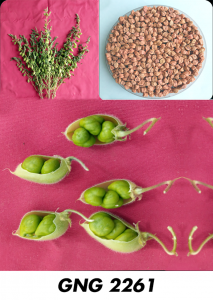
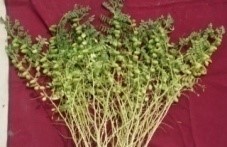
Cotton: RS 2827
American cotton variety RS 2827 developed by AICRP on Cotton of ARS, Sriganganagar for high density planting system has been released and notified vide notification No. S.O 8(E) dated 24.12.2021 for cultivation in North Zone of India including North West Rajasthan. It has been derived from the cross between LH 2108 X F 1638. The variety has showed consistent yield superiority in coordinated varietal trials at different locations in North Zone of India during Kharif 2016-17 to 2018-19. It has given 15.5 and 23.7 percent seed cotton yield superiority under High Density Planting over Zonal Check CSH 3075 and Local Check, respectively. Under closer spacing (67.5 x 20 cm) the cotton variety RS 2818 has good average Seed Cotton Yield potential of 3054 kg/ha ranging from 2207 to 3792 kg/ha. The average lint yield potential of RS 2827 is 1016 kg/ha ranging from 717 to 1233 kg/ha. This variety has showed relatively better disease tolerance (tolerance) against CLCuD. RS 2827 has good fiber quality with average Micronaire value (µgm/inch) of 4.38, Fibre length (UHML) of 27.22 mm and Fibre strength (Tenacity) of 28.86 g/tex. It possesses a good level of oil (17.2 percent) also. This variety has good boll weight of 3.3 gm/boll with Ginning out turn of 33.3 percent.
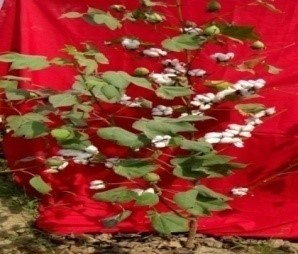
Cotton: RS 2818
American cotton variety RS 2818 developed by AICRP on Cotton of ARS, Sriganganagar for high density planting system has been released and notified vide notification No. S.O 8(E) dated 24.12.2021 for cultivation in North Zone of India including North West Rajasthan. It has been derived from the cross between H 2132 X F 2052. The variety has showed consistent yield superiority in coordinated varietal trials at different locations in North Zone of India during Kharif 2016-17 to 2018-19. It has given 16.9 and 25.2 percent seed cotton yield superiority under High Density Planting over Zonal Check CSH 3075 and Local Check, respectively. Under closer spacing (67.5 x 20 cm) the cotton variety RS 2818 has good average Seed Cotton Yield potential of 3090 kg/ha ranging from 2047 to 3984 kg/ha. The average lint yield potential of RS 2818 is 1074 kg/ha ranging from 700 to 1365 kg/ha.This variety has showed relatively better disease tolerance (tolerance) against CLCuD. RS 2818 has good fiber quality with average Micronaire value (µgm/inch) of 4.46, Fibre length (UHML) of 27.36 mm and Fibre strength (Tenacity) of 29.38 g/tex.
It possesses a good level of oil (17.85 percent) also. This variety has good boll weight of 3.2 gm/boll with Ginning out turn of 34.6 percent.
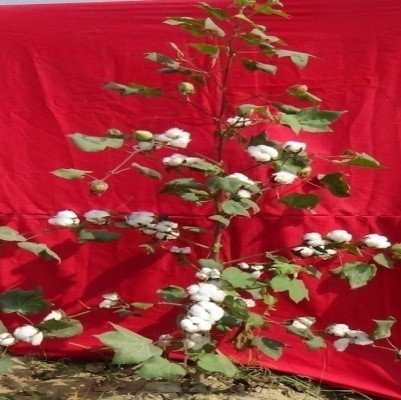
Acid Lime
Ganganagar Acid Lime-1:
- Acid lime variety “Ganganagar Acid Lime – 1 (SGNR AL-1)” (IC No.– 0611556) notified for release in Rajasthan state vide gazette notification no. S.O. 1480 (E) dated 01.04.2021 by Ministry of Agriculture and Farmers Welfare, Department of Agriculture, Cooperation and Farmers Welfare, New Delhi.
- Premium attributes of this variety are: fruit thin skinned, less seeded (mere 5-6), highly juicy (52%), profuse bearer, deep yellow in colour and resistant to citrus canker which is most common and severe disease in case of acid lime cultivation. Average fruit yield 42-45 Kg per tree at the initial age of 4 to 5 years.
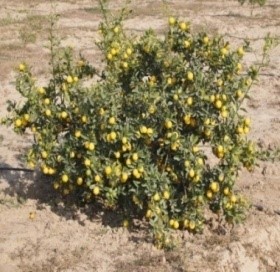
Fodder crops varieties
Lucerne-Krishana (2016) at all India level
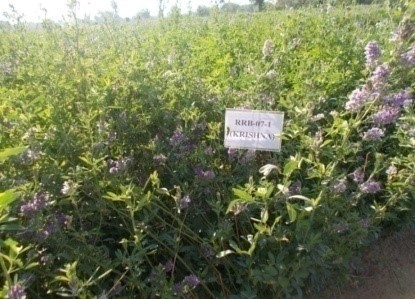
Pearl millet-Raj bajra-1 (2015)
for Rajasthan state
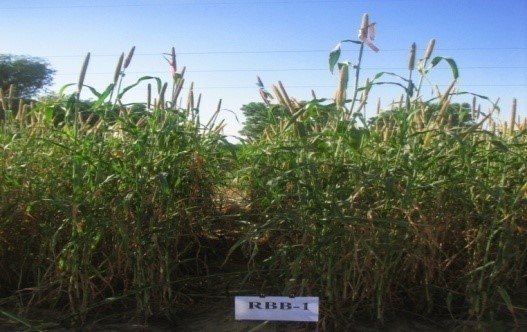
Dhaman grass-Bikaneri dhaman (2015)
for Rajasthan state
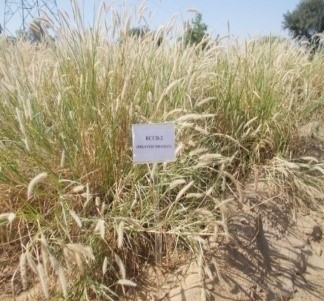
Sewan grass-Jaisalmeri sewan (2016)
at all India level
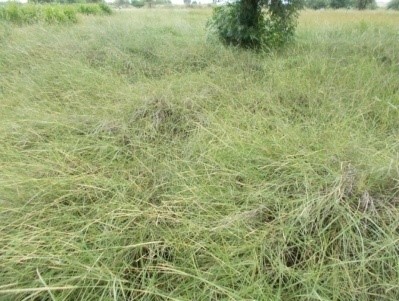
Technology Recommendations
During the period of 2021-22 to 2023-24 SKRAU, Bikaner scientists have developed more than 76 production and protection technologies for North -Western Rajasthan. However, some of important improved technologies developed and recommended for adoption by farmers in western part of Rajasthan are given below-
ARS, Bikaner
Recommendations to be included in PoPRabi, 2021-22 of Zone 1c
|
S. No. |
Crop |
Technical |
|
1. |
Dill |
To achieve targeted yield under IPNS for which fertilizer needs of dill was recommended after soil test values. For this following generated fertilizer prescription equations were computed as :
Fertilizer Nitrogen (kg/ha) = 8.80 target yield -0.72 soil Nitrogen – 1.57 Organic nitrogen Fertilizer Phosphorus (kg/ha) = 3.99 target yield -0.92 soil phosphorus – 1.40 Organic phosphorus Fertilizer Potash (kg/ha) = 4.40 target yield -0.23 soil potash – 0.82 Organic potash Here, target yield in q/ha, soil available nutrients in kg/ha and nutrient contents in organic matter in kg/ha Organic matter is used for increase the efficiency of nitrogen, phosphorus and potash fertilizer is recommended. Use of above generated fertilizer prescription equations, decrease the doses of fertilizer after incorporation of organic matter. |
|
2. |
Lucerne |
Lucerne seed production in Zone Ic the Lucerne: Fennel intercropping is better in 15:1 ratio for better pollination, seed setting and good seed production. |
|
3. |
Agri-Horti Pasture system |
Agri-horti-pasture system all the fruit trees showed more growth characters with intercropping rather than their sole plantations. In drip irrigation intercrop yields were 15-37% higher with citrus over their sole cropping. The Intercropping of rainfed cluster bean with bael (drip irrigation) gave highest LER (1.67) and cluster bean equivalent yield (48.54 q/ha) followed by acid lime & Lowest was with Gonda+ Sewan.
In sprinkler irrigation the green gram, cluster bean and linseed intercropping with shisham yielded 16-38 % higher over acid lime. Highest LER was recorded with acid lime + Aloe vera (1.99) followed by Safflower (1.92). |
|
4. |
Gram |
Chick pea varieties viz: GNG-2171, GNG-2261, GNG-2207 and GNG-2144 are suitable for cultivation in Zone Ic. |
|
5. |
Wheat |
Wheat varieties Raj -4079 and HD-3059 are suitable for cultivation in Zone Ic |
|
6. |
Fenugreek |
Fenugreek varieties FG-2, AFG-4 and AFG-5 are suitable for cultivation in Zone Ic |
|
7. |
Lucerne |
Lucerne variety Krishna is suitable for cultivation in Zone Ic |
|
8. |
Mustard |
Application of irrigation at 70% ET (about 260–270mm) and 120 kg N ha-1 is suitable to get better yield and water productivity of Indian mustard in Bikaner region. Foliar application of salicylic acid @ 0.5 mM (69 mg per liter) at 45 and 65 DAS is effective to get better yield under water deficit conditions. |
Recommendations to be included in PoP Rabi, 2022-23 of Zone 1c
|
S. N. |
Crop |
Technical |
|
1. |
Fennel |
Fennal varieties RF-290 and RF-281 are suitable for cultivation in Zone Ic |
|
2. |
Long melon |
Low tunnel technology for early harvest of long melon var. Thar Sheetal sowing on 20th December with polythene covering was found the best in terms of crop advancement, yield and net economic return to the farmers. |
|
3. |
Wheat |
Wheat varieties Raj 4238, DBW 187 and DBW-303 are suitable for cultivation in Zone Ic |
|
4. |
Cumin |
Saline water up to EC iw 6 ds/m could be used through drip irrigation in cumin crop on sandy soil in arid region of Rajasthan. |
|
5. |
Taramira |
Taramira production in rainfed condition when rainfall is greater than 2.5 cm (25 mm) during last week of September to first week of October is appropriate for taramira cultivation with 1.5 kg per hectare seed rate and 50 cm row to row spacing in Zone Ic |
Recommendations to be included in PoP Kharif, 2023 of Zone Ic
|
S. N. |
Crop |
Technical |
|
1. |
Groundnut |
Seed treatment with Tebuconazole 2DS @ 1.5 g/kg of seed of groundnut for reduce collar rot disease and higher pod yield (24.39%) and straw Note: Seed treatment with Tebuconazole 2DS should be @ 1.5 g/kg of seed of groundnut not more than 1.5 g/kg of seed. |
|
2. |
Groundnut |
Groundnut pod storage up to 8 months without losses of aflatoxin contamination and insect infestation with the use of PIC (Purdue Improved Crop Storage) bags. (Moisture level less than 10 per cent of storage groundnut) |
|
3. |
Groundnut |
Application of Diclosulam (84%) 25 g ha-1as P.E. effective for weed management in groundnut. |
|
4. |
Pearl millet |
Moisture conservation through polymers and crop residues under rainfed conditions: Significantly higher net return and B:C ratio in treatment RDF + Pusa hydrogel slurry application @ 5 Kg. ha-1. This treatment was economically viable. |
|
5. |
Pearl millet |
Pearl millet verities i.e., BHB-1602 and RHB-223 are found suitable for cultivation in Zone Ic. |
|
6. |
Date palm |
For increasing more number of roots and higher survival of offshoots in the field, the offshoots should be treated with mixture of sand and FYM (1:1) in fertilizer bags for six month with regular moisture and after that detached from mother plants and shifted in polybags for two month. |
|
7. |
Date palm |
The Halawy variety is suitable for early crop with good quality fruits and Barhee variety is suitable for late crop with good quality fruits at doka stage in western Rajasthan. The Khuneize variety is suitable for early and mid-season crop with good quality and red colour fruit. |
|
8. |
Sponge gourd |
Use of an improved variety Thar Tapish tolerant to high temperature with complete package of practices (sowing method, nutrition) is recommended for cultivation during rainy and summer season for producing higher yield over existing varieties and production system under hot arid climate of Rajasthan. |
|
9. |
Napier Bajra |
Micronutrient management is beneficial for BN Hybrid Napier Bajra. |
|
10. |
Map Preparation |
Survey, Characterization and preparation of map of underground water quality for irrigation of Barmer district of Rajasthan |
Recommendations to be included in PoP Kharif, 2024 of Zone 1c
|
S. No. |
Crop |
Recommendations |
|
1. |
Groundnut |
Groundnut varieties viz; RG-510 and RG-638 are suitable for cultivation in Zone Ic. |
|
2. |
Groundnut |
In small seeded varieties of groundnut one to two irrigations can be skipped at vegetative phase while, in bold seeded varieties it causes significant yield losses. |
|
3. |
Clusterbean |
Based on results of ARS Bikaner and ATC Lunkarnasar clusterbean verities RGR-18-1 and RGR -12-1 are recommended for inclusion of PoP of this zone. |
|
4. |
Clusterbean |
Based of efficacy of different herbicides pendimethalin and imazethapyr 800 gm a.i./ha as pre-emergence recommended for weed control in clusterbean. |
|
5. |
Pearl millet |
Pearl millet verities HHB-299 and PC-701 are recommended for zone –Ic. |
|
6. |
Seasame |
Based on the characteristic of seasame variety RT-372 is recommended for zone Ic because it contains 48-50% oil content moderately resistant to macrophomina stem and root rot, phyllody and shattering resistant. |
|
7 |
Snapmelon |
The standardized production technology of snapmelon i.e. 15th February sowing with drip system, 50% RDN+45% N through FYM+5% N through VC+P+K (80:40:40 N:P:K kg/ha), var. AHS-82 and seed rate of 2.0 kg/ha is recommended for cultivation during rainy and summer season for producing higher yield and quality over the existing production system under hot arid climate of Rajasthan. |
|
8. |
Clusterbean |
Foliar spray with tebuconazole 25.9 EC @ 0.1 % is an effective treatment for management of alternaria blight in clusterbean under field conditions and also increased seed yield. |
|
9. |
Pearl millet |
It is recommended that dry application of Pusa Hydrogel @ 5.0 Kg ha-1 gave higher grain yield, net return & B:C ratio under moisture stress condition. |
|
10. |
Pearl millet |
It is recommended that biofortified hybrid of pearl millet HHB-299 with application of ZnSO4 (25kg/ha) + FeSO4 (20kg/ha) + 0.2 % borex gave higher grain yield, net return & B:C ratio. |
|
11. |
Pearl millet |
It is recommended that follow complete package practices to get higher grain yield, net return & B:C ratio. |
|
12. |
Pearl millet |
It is recommended that application of 112.5 % RDN with three splits application of nitrogen [25% basal + 50 % of N at tillering (20-25 DAS) + 25 % of N at boot stage (35-40 DAS)] gave higher grain yield, net return & B:C ratio. |
ARS Sriganganagar
Recommendations to be included in PoP Rabi, 2021-22 of Zone 1b
|
S. No. |
Crop |
Recommendations |
|
1. |
Gram/ Chickpea |
GNG-2261: The desi chickpea GNG 2261 (Keshav) developed by AICRP on Chickpea, ARS, Sriganganagar was identified and released for late sown irrigated conditions Rajasthan in 33rd meeting of State Seed Sub Committee held on 23.08.2019. This variety has been derived from the cross between GNG 1581 x Pusa 1103. This Variety has shown a good level of tolerance against wild disease. It has showed relatively better tolerance against most prevailing diseases like Root Rot, Ascochyta Blight and Stunt. It possesses a good level of protein (21.28 percent) also. This variety has an attractive medium seed size (15.0 gm/100 seeds) with profuse branching and semi erect plant type. It matures in about 128 days. The observed average grain yield potential of this variety is 2413 kg/ha. |
|
2. |
Bottle gourd |
Drip and fertigation schedule in Bottle Gourd |
|
3. |
Citrus |
Newly released citrus variety: Ganganagar Acid Lime-1: Its fruits are thin skinned, highly juicy (52.6%), less seeded (5-6), TSS 7.0 0Brix, acidity 6.1%, ascorbic acid 32 mg/100 g, juice (58.6 %), rind thickness (1.11 mm), fruit weight (28-30 g), deep yellow in color and resistant to Citrus canker. Average yield at the age of 4-5 years noted 50-60 Kg per plant. Fruiting obtained twice in a year first in the month of August – September and second in January to March. |
|
4. |
Sugarcane |
Spray of chlorantraniliprole 18.5 % SC @ 0.25 ml/lit. of water for the management of Sugarcane borer complex |
|
5. |
Berseem |
Barseem Ludhiana-43 (BL-43): The variety has been developed by PAU, Ludhiana and released in 2017. It is a quick growing, early maturing tall variety with more number of tillers. It yielded about 98t/ha green fodder and gives good seed yield. The variety is moderately resistant to stem rot diseases. For good seed production, do its last cutting by the end of March. |
Recommendations to be included in PoP Kharif, 2022 of Zone 1b
|
S. No. |
Crop | Recommendation |
|
1. |
Cotton |
American cotton new variety RS 2818 and RS 2827 |
|
2. |
Desi Cotton |
Foliar spray of Chlorantraniliprole 18.5 SC @ 0.3ml/lt of water against bollworm complex in desi cotton. |
|
3. |
Desi Cotton |
Technology for organic desi cotton production |
|
4. |
Cotton |
Foliar spray of Salicylic acid @ 50ppm as osmo-protectant – Single sprays (90 DAS) for stress management in Bt cotton. |
|
5. |
Mungbean |
New variety MH 1142 |
|
6. |
Okra |
Optimum irrigation schedule for okra through drip under different crop geometries. |
|
7. |
Clusterbean |
Foliar spray of Maleic Hydrazide (MH) @ 500 ppm (75 DAS) as growth retardant. |
Recommendations to be included in PoP Rabi, 2022-23 of Zone 1b
|
S. No. |
Crop |
Recommendations |
|
1. |
Wheat |
Irrigated timely sown high yielding wheat variety DBW 187 (Karan Vandana) |
| Irrigated timely sown high yielding wheat variety DBW 222 | ||
|
2. |
Chickpea |
Integrated Management of Sclerotinia stem rot: Seed treatment (ST) with Carboxin 37.5% + Thiram 37.5% (75 WP) @ 2g/kg seed, avoid irrigation during 25th Dec. to 15th Jan and foliar spray of Propiconazole 25 EC @ 0.1% or Carbendazim 12% + Mancozeb 63% (75 WP) @ 2g lit-1 of water at 60-65 DAS. |
|
3. |
Chickpea |
Spray of Emamectin Benzoate 5 WG @ 0.5 g + 2% Potassium Nitrate (20g KNO3) per litre of water at pod formation stage can be use for pod borer management and higher yield. |
|
4. |
Sugarcane |
Sugarcane Variety (Early) C-Pb 14211
Subject to notification of the variety |
|
5. |
Sugarcane |
Spray of chlorantraniliprole 18.5% SC @ 0.25 ml/lit for the control of sugarcane borer complex (early shoot borer and internode borer and root borer). |
|
6. |
Water management |
Cauliflower: Drip irrigation schedule in cauliflower |
| Carrot: Drip irrigation schedule in carrot |
Recommendations to be included in PoP Kharif, 2023 of Zone 1b
|
S. No. |
Crop | Recommendation |
|
1. |
Bt Cotton |
Parawilt control in Bt Cotton: In August-September month during boll formation in Bt Cotton plant show sudden wilting symptoms due to excess use of saline water. Use 1.0 g Cobalt Chloride + 50 g Sodium Benzoate in 100 litre waters within 24 hours foliar application help to mitigate the parawilt effect on Bt Cotton.
Note: Don’t mix Cobalt Chloride in water with bare handed. Use Plastic or wood stick to mix it in water. |
|
2. |
Bt Cotton |
Recommendation of Bt Cotton hybrids for Kharif-2023 in Rajasthan |
|
3. |
Chilli |
Spray of spinetoram 11.7 SC @ 0.84 ml per liter of water for the management of chilli thrips. Use spiromesifen 22.9 SC @ 1.20 ml per liter of water for the management of chilli mite |
|
4. |
Sesamum |
New Varieties of Sesame (Til) RT-351 and RT-372 |
|
5. |
Bajra |
New Variety HHB-299 |
Recommendations to be included in PoP Rabi, 2023 -24 of Zone 1b
Recommendations to be included in PoP Kharif, 2024 of Zone 1b
|
S. No. |
Crop |
Recommendations |
|
1. |
Cotton |
Insecticide Spinetoram 11.7 SC @ 420 ml/ha was found effective against bollworm complex of cotton |
|
2. |
Cotton |
Insecticides Afidopyropen 50 DC @ 1.50 ml/liter was found effective against sucking pests of cotton |
|
3. |
Mungbean |
100% RDF + VAM Soil application @ 5 kg/ha significantly enhanced the grain yield in mungbean |
|
4. |
Mungbean |
The mungbean sowing can also be done in second fortnight of June (15-30 June), if seasonal rains come early during kharif season. |
|
5. |
Mungbean |
In mungbean, row to row spacing of 45 cm may be kept using 12 kg/ha seed. |
|
6. |
Mungbean |
In mungbean, seed treatment with T. harzianum @ 10 g/ kg seed + soil application of T. harzianum @ 10 kg/ha (Mixed in 200 Kg FYM) before sowing was observed effective for the management of soil borne diseases: For the management of soil borne diseases (Root rot, wilt & stem rot) of Mung bean, the minimum average plant mortality/ affected (%), maximum yield (9.76 q/ha) and highest benefit cost ratio (3.24) were observed in treatment T4 (ST with T. harzianum @ 10 g/ Kg seed + SA of TH @ 10 kg/ha (Mixed in 200 Kg FYM) before sowing. |
|
7. |
Clusterbean |
In clusterbean, seed treatment with T. harzianum @ 10 g/ kg seed + soil application of T. harzianum @ 10 kg/ha (Mixed in 200 Kg FYM) before sowing was found better for the management of soil borne diseases: For the management of soil borne diseases (Root rot, wilt & stem rot) of cluster bean, the minimum average plant mortality/affected (%), maximum yield (10.39 q/ha) and highest benefit cost ratio (2.51) were recorded under the treatment T4 (ST with T. harzianum @ 10 g/ kg seed + SA of TH @ 10 kg/ha (Mixed in 200 Kg FYM) before sowing. |
|
8. |
Okra |
Foliar spray of Flonicamid 50 WG @ 0.4 gm/liter of water against jassid and Chlorantraniliprole 18.5 SC @ 0.28 ml/ha was found effective against fruit borerin Okra. |
Post harvest technology
Date Palm:
|
Nutritive value
|
Status Date palm is grown on 275 hectare area in Bikaner district. Date palm in India does not attain pind (soft date) stage on trees due to rains coinciding the ripening period of fruits (June end to September). Therefore, mostly fruits are harvested at doka stage (hard ripe stage). |
Products developed
|
|
|
|
|
Bajra (Pearl Millet):
Energy: 361 Kcal. Protein: 11.6 g Fat: 5.0 g, Fiber: 1.0 g Carbohydrate: 67.5 g Ca: 42.0 mg., Fe: 8.0 mg P: 296. mg., ZN: 3.1 mg. |
Status More than 50% of area under Bajara cultivation is in Rajasthan. Peal millet is not under consumption in the urban population. Also pearl millet flour is having low shelf life and develop rancidity. Pearl millet can be subjected to various processing techniques like blanching, germination, soaking to overcome problems of poor digestibility, bitter taste and rancidity. |
Products developed
|
|
|
|
|
Seed Production
Seed is the basic input in agriculture. Seeds are highly remunerative to increase the productivity level on per unit basis as the land resource is also a limiting factor. One of the frontline approaches is continuous development of new and improved crop varieties as well as a vibrant system of producing quality seed and its timely availability to the farmers of the state. Seed replacement rate has a strong relationship with the increase in the productivity levels. Seed replacement rate should have been 25-35 percent for most of the crops. The university is fulfilling this need through National Seed Project, which is coordinating the breeder seed production programme being undertaken at different farms of research stations and seed farms. University is taking special measures to produce breeder seed of important crops of the state to full fill the requirement of various public and private sector seed producing agencies, which has resulted in manifold increase in quality seed production. During 2021-22 to 2023-24 total 10646.40 quintal quality seed of various categories was produced at different ARS/ARSS/KVKs/Seed farms. During these year, total 2994.94 quintal breeder seed of different crops was produced. In addition to breeder seed, 7651.46 quintals of T/L (Truthfully labelled seeds) seeds of improved varieties of field crops were also produced.
Table: Breeder and TL Seed Production (in quintals) of different crops for last three years
|
S. No. |
Crops |
2020-21 |
2021-22 |
2022-23 |
Total |
|||
|
BS |
TL |
BS |
TL |
BS |
TL |
|||
|
1. |
Wheat |
90.68 |
811.41 |
– |
734.69 |
– |
890.22 |
2527.00 |
|
2. |
Barley |
– |
506.47 |
– |
290.26 |
– |
420.48 |
1217.21 |
|
3. |
Chickpea |
841.21 |
144.00 |
752.48 |
431.24 |
968.62 |
120.50 |
3258.05 |
|
4. |
Mustard |
0.20 |
112.08 |
2.20 |
211.25 |
2.17 |
206.91 |
534.81 |
|
5. |
Fenugreek |
– |
– |
– |
– |
– |
5.63 |
5.63 |
|
6. |
Groundnut |
30.00 |
407.00 |
18.00 |
387.00 |
3.00 |
283.00 |
1128 |
|
7. |
Sesame |
– |
– |
– |
– |
– |
0.25 |
0.25 |
|
8. |
Guar |
58.61 |
138.12 |
11.20 |
401.12 |
36.00 |
503.59 |
1148.64 |
|
9. |
Moth |
41.29 |
38.21 |
37.80 |
86.29 |
28.60 |
157.27 |
389.46 |
|
10. |
Mung |
50.18 |
88.94 |
5.20 |
159.06 |
13.00 |
113.02 |
429.40 |
|
11. |
Cowpea |
– |
– |
– |
– |
– |
3.20 |
3.20 |
|
12. |
Bajra |
– |
– |
– |
– |
2.00 |
2.00 |
|
|
13. |
Cotton |
2.50 |
– |
– |
– |
– |
0.25 |
2.75 |
|
Total |
1114.67 |
2246.23 |
826.88 |
2700.91 |
1053.39 |
2704.32 |
10646.40 |
|
Note: BS = Breeder Seed, TL = truthfully labelled
Research Activities
